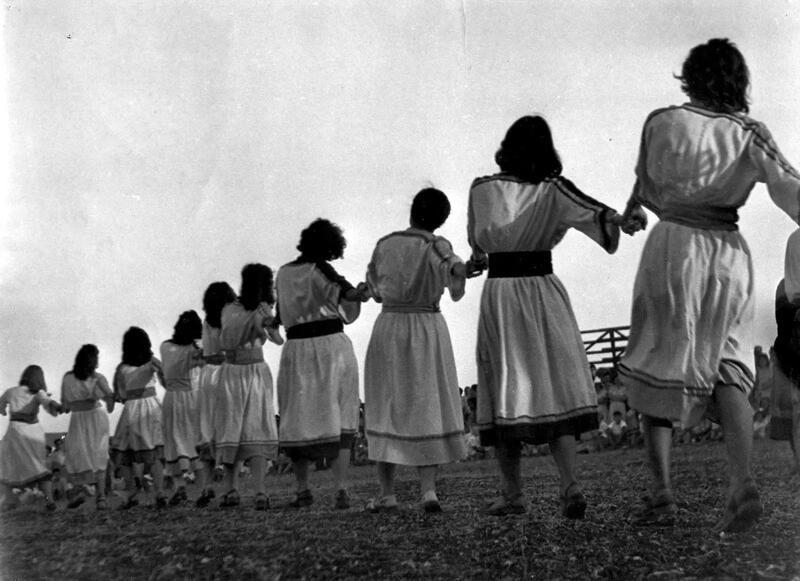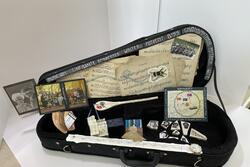Tu B’Av is More than “Jewish Valentine’s Day”
If you’ve heard of Tu B’Av, which begins on the evening of August 11 this year, you’ve probably heard that it’s a kind of late-summer Jewish Valentine’s Day. In Israel, it’s become a popular date for weddings and parties, and it’s starting to catch on in the US, too.
Although Tu B’Av dates back to the days of the Second Temple, the holiday as we understand it now only recently re-entered Jewish life. In its original form, Tu B’Av wasn’t really a holiday about love; the few surviving documents that reference it describe it, instead, as a minor harvest festival with practices revolving primarily around young women.
One of the only mentions of Tu B’Av as an ancient holiday is found in the Mishnah: “There were no days as joyous for the Jewish people as the fifteenth of Av and as Yom Kippur, as on them the daughters of Jerusalem would go out in white clothes, which each woman borrowed from another…And the daughters of Jerusalem would go out and dance in the vineyards.” The dancing happened under the full moon, which happens around the fifteenth day of each month on the Jewish calendar.
The passage also includes a reference to matchmaking, explaining that as they danced, the women would call out to the young men watching: “Lift up your eyes and see what you choose for yourself for a wife. Do not set your eyes toward beauty, but set your eyes toward a good family.”
There are some explanations for why the holiday is observed on the fifteenth of Av, although none of these are definitive. The Talmud attributes several positive events to this date—for example, the end to a ban on intermarriage between tribes of Israelites. There are also agricultural explanations; some passages describe Tu B’Av as a holiday celebrating the start of the grape harvest, which would explain the custom of dancing in vineyards. Others suggest that it was the last day of the wood-cutting season, the dry season, or the planting year.
In the last couple of centuries, some have viewed Tu B’Av as a festive complement to the somber Tisha B’Av, which occurs only six days earlier and commemorates a number of tragic events throughout Jewish history, most notably the destruction of the First and Second Temples in Jerusalem. Early Hasidic works describe Tu B’Av as a "sweetening and a repair of the ninth of Av,” allowing people to end the month on a positive note. Tu B'Av is also the last holiday of the Jewish year, so this emphasis on sweetening, repair, and renewal makes sense as a bridge between Tisha B’Av and the High Holidays.
So, how exactly did the holiday transform into “Jewish Valentine’s Day”? It’s not entirely clear, but it began to experience a minor resurgence in the nineteenth century with the Haskalah (Jewish Enlightenment) movement, which encouraged the study and revival of ancient holidays and customs. Some writers within the movement, such as Abraham Mapu and Judah Leib Gordon, wrote books and poetry in Hebrew that described the celebration of these holidays, including Tu B’Av, in biblical locations.
There isn’t much documentation of people actually observing Tu B’Av again until the early twentieth century, when Jews in both Europe and Palestine began trying to revive it. Members of the early Bais Yaakov movement, a revolutionary Jewish women’s education movement that has since been adopted into mainstream Orthodox Judaism, have written about Tu B’Av celebrations in the 1920s and 1930s throughout Poland, calling it a “historical women’s holiday.” During these celebrations, students and teachers would hike into the woods, light bonfires, and, as is described in the Mishnah, sing and dance together. Unlike the description in the Mishnah, these Tu B’Av celebrations were unrelated to matchmaking and had no male onlookers; those present emphasized them being about female participants connecting with each other.
At around the same time, some Jews living in Palestine also attempted to establish yearly Tu B’Av celebrations. In 1925, several kibbutzim held Tu B’Av festivals for young women, where participants similarly tried to celebrate it as it was originally described. These celebrations were relatively unpopular and didn’t gain much momentum. In the 1990s, however, Tu B’Av began to be promoted in Israel as an equivalent to Valentine’s Day, and that’s when it started to catch on.
Tu B’Av is a secular holiday in Israel—it isn’t recognized by the Israeli rabbinate and is a regular workday. Although it is still only moderately popular, companies have capitalized on it—it’s becoming increasingly common to exchange gifts, flowers, and cards on Tu B’Av, and to hold parties, performances, and singles events. Interestingly, White Parties, which reference the initial tradition of dressing in white on Tu B’Av, are also becoming popular in both American and Israeli cities, although they seem to be little more than regular parties for “young professionals” with an all-white dress code.
The evolution of Tu B’Av is similar to the story of the real Valentine’s Day, which historians believe began in part as a Roman fertility holiday called Lupercalia that was celebrated on February 15. Like Tu B’Av, Lupercalia was an agricultural festival with a matchmaking element. It was also a pagan holiday dedicated to Faunus, the Roman god of agriculture, and its festivities included (among other events, such as sacrificing a goat and dog) young men drawing the names of young women from a large urn and being “paired” with them for the rest of the year.
At the end of the fifth century, in an attempt to deter pagan holidays, Pope Gelasius I outlawed Lupercalia and declared February 14 St. Valentine’s Day, a commemoration of the anniversary of St. Valentine’s death. But Valentine’s Day did not yet take on a definitive association with love; it remained primarily associated with festivals, drinking, and revelry until 1375, when Geoffrey Chaucer described it in his poem “Parliament of Foules” as the day “Whan every foul cometh ther to choose his mate.” As the holiday became more popular in Britain and the rest of Europe, the association grew, and it became popular to exchange cards and handmade tokens. Now, like Tu B’Av, Valentine’s Day is primarily successful because of its commercial elements.
In its own way, Tu B’Av underwent the same Christianization and commercialization as Lupercalia. Although Valentine’s Day no longer has any religious elements outside of its name, it still has undeniably Christian origins and an ongoing association with Christianity; there has even been some discussion of whether Jews should celebrate it.
It’s not surprising that Tu B’Av didn't catch on in its original form and was only successful when reframed as something more marketable. Still, I couldn’t help but feel disappointed when I found out how much it has changed. Although it’s exciting to revive ancient holidays and customs, much of this particular holiday has been abandoned in favor of commercial success. And to make things even more disappointing, in its original form the customs around Tu B’Av were explicitly for young women, which can’t be said for many other Jewish holidays.
The good news is that this poses an exciting opportunity for Jewish women to reclaim Tu B’Av…maybe without the male onlookers. Although this holiday may have initially been about matchmaking, there are so many ways we can reinterpret it and the rituals associated with it in service of female empowerment and connection—which sounds much more fun than just exchanging cards or going out to dinner. That’s why, this year, my Jewish female friends and I will be recreating the original Tu B’Av celebrations as best we can—and you can do it too! Get some wine, dress in your best clothes, and go dance in a field somewhere under the full moon.







